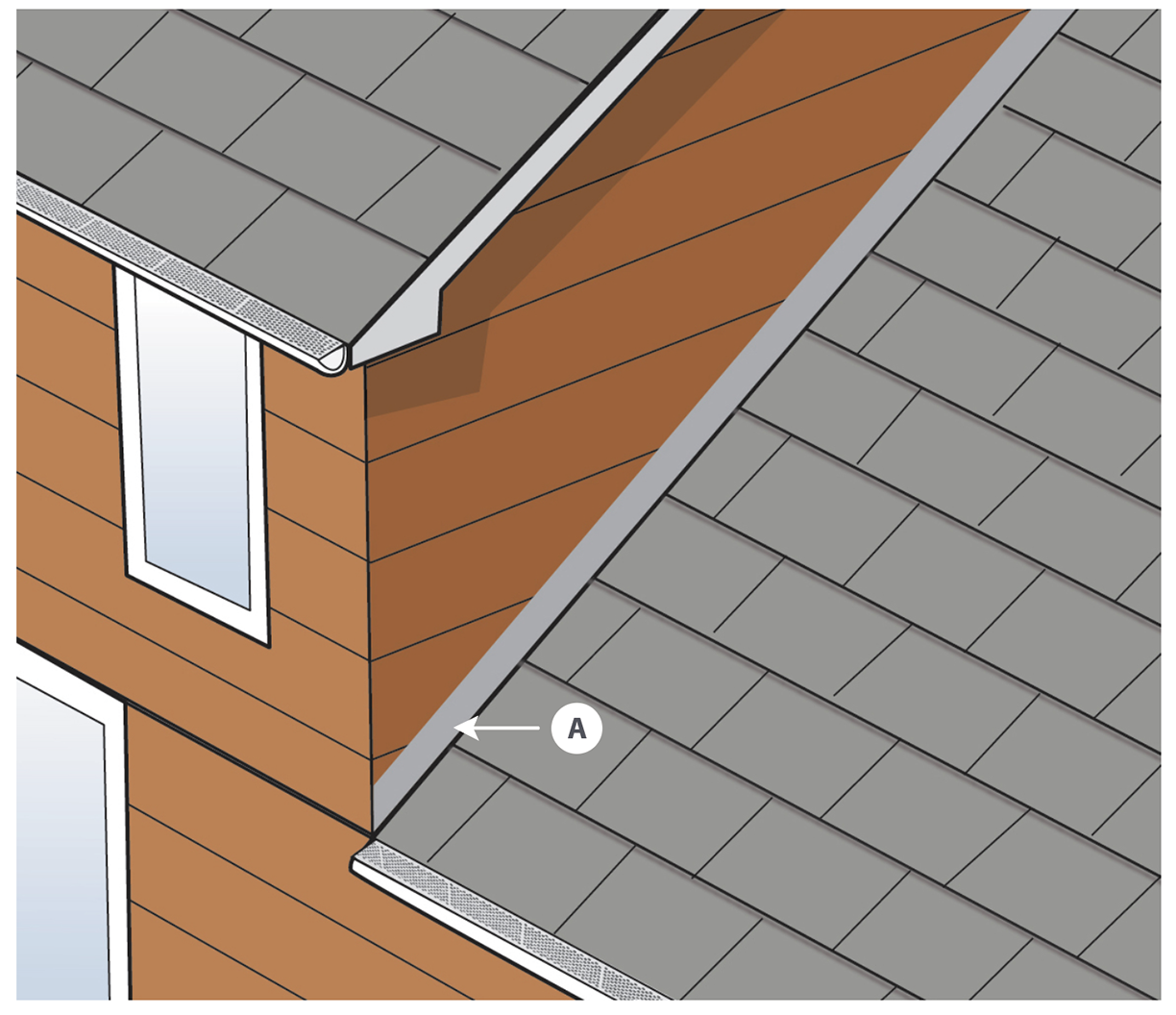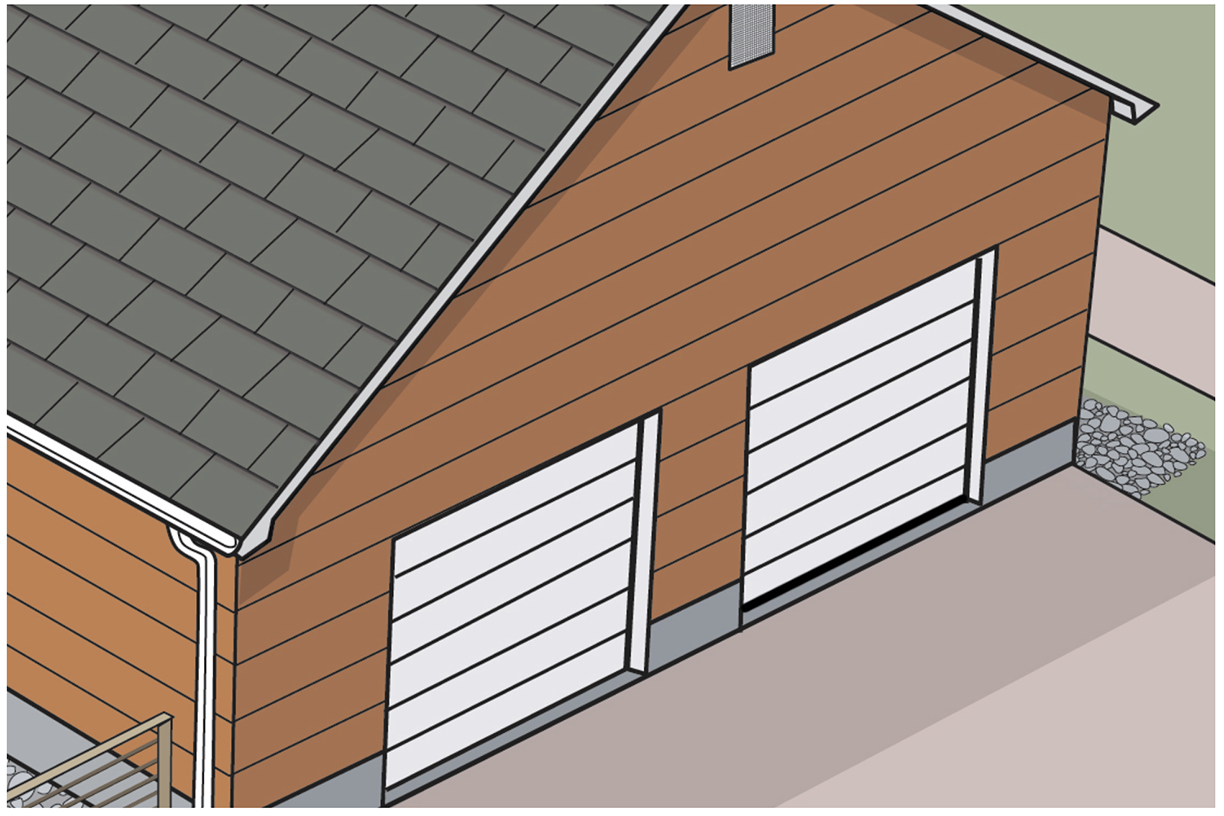How to Make My Home Fire Safe
In wildfire events, 60-90% of home loss is due to embers traveling ahead of a fire and igniting the home or combustible material near the home. The information below provides specific recommendations for “Home Hardening,” or retrofitting existing components of a home to withstand ember ignition during a wildfire. Each section explains how the component is vulnerable and what can be done to improve that component.



A Fill this space with a noncombustible material, such as a mineral wool insulation product
B Class B or C fire-rated roof covering
C Roof sheathing
D Additional fire-resistant layer
Roofs
How to reduce the vulnerability of roofs
- Replace a wood shake or shingle roof with a Class A roof.
- Remove accumulated vegetative debris from the roof.
- If there is a space between the roofing materials and roof deck, make sure that the openings between the covering and the roof deck are blocked.
- Repair areas as needed.
- If the roof consists of Class B or C roofing materials, determine if the underlayment in the assembly provides Class A protection as indicated in manufacturer installation instructions. When viewed from the edge of the roof, these materials would either look like gypsum wallboard or overlapping 4-foot wide sections of an asphalt composition roof covering. Maintain the roof covering and replace with a Class A product when needed.

A Keep roofs clear of vegetative debris and install metal flashing at roof-to-wall intersections.
Roof Edges
How to reduce the vulnerability of roof edges
- Remove accumulated vegetative debris from roofs on a regular basis.
- Replace the combustible siding in roof-to-wall locations with a noncombustible option. Replacement of siding only in these locations will be less expensive than replacing all the home’s siding. It may be possible to find a noncombustible siding pattern that is similar to the existing siding pattern.
- At a roof-to-siding location, use of metal flashing that extends up the siding at least 6-inches could also reduce the vulnerability of a combustible siding material. Install flashing so that water cannot get between flashing and siding.

Rain Gutters
How to reduce the vulnerability of rain gutters
- Remove vegetative debris from gutters on a regular basis during fire season.
- Install a noncombustible and corrosion-resistant metal drip edge to provide protection for the combustible components (i.e., sheathing and fascia) at the edge of your roof.
- Use a noncombustible gutter cover to minimize accumulation of debris in the gutter. Some gutter covers result in accumulation of debris on the roof behind the gutter, so these will still require routine maintenance.


Eaves
How to reduce the vulnerability of eaves
- Inspect open-eave areas for gaps where embers could lodge or pass through into the attic. All vents should be screened and all other gaps should be filled with durable caulk.
- Enclose under-eave area to create a soffited eave.


Vents
How to reduce the vulnerability of attic and crawl spaces
- Avoid storing combustible items (e.g., cardboard boxes, newspapers and magazines) near attic or crawl space vents.
- Inspect vents to make sure they are in good condition (i.e., screen is in good condition with no tears that would result in larger openings).
- If ¼-inch mesh screening is present, replace or add, at a minimum, a ⅛-inch noncombustible corrosion resistant metal mesh screen.
- Consider replacing vents with a flame- and ember-resistant option.

A Combustible siding
B 6-inch concrete foundation
C Gravel ground cover
Siding
How to reduce the vulnerability of siding
- Use noncombustible siding (e.g., stucco, steel and fiber cement), especially when neighboring homes are within 30-feet of the home.
- Make sure to develop and maintain adequate defensible space, particularly within the ember-resistant zone, to minimize the chance that siding will ignite from embers at the ground level or direct-flame contact from nearby combustible materials.
- In smaller areas that are vulnerable, such as at a roof-to-wall area, replace siding with a noncombustible product.
- For new construction, use of a one-hour wall design, where an additional fire resistant layer is used in the wall assembly, can provide additional protection when a more vulnerable siding material is used.

Skylights
How to reduce the vulnerability of skylights
- Remove vegetative debris from the roof, including on and adjacent to skylights, on a regular basis.
- On sloped roofs, glass skylights are the best choice because of increased likelihood of exposure to radiant heat.
- If the skylight can open, close it when wildfire is threatening to prevent embers from entering the home. Consider adding a 1/16-inch noncombustible corrosion resistant-metal mesh screening to reduce ember intrusion into the home in case the skylight cannot be closed before evacuation.

Windows
How to reduce the vulnerability of windows
- When replacing windows, choose multi-pane options containing tempered glass.
- If neighbors or outbuildings are within 30-feet of the home, consider installing deployable noncombustible shutters to provide additional protection.
- Install screens in all operable windows. Screens increase ember resistance by keeping embers out of the home and also decrease radiant heat exposure.
- Close windows when wildfire is threatening.


A Siding
B Minimum 6 inches
C Install metal flashing between the ledger board and joists to protect the combustible siding material. The flashing should extend above and below the ledger board.
D Replace the deckboard next to the house with noncombustible material.
E Ledger board
F Metal flashing
Decks
How to reduce the vulnerability of decks
- Create an ember-resistant zone under the footprint of and around all decks. This action will reduce the likelihood of under-deck flame exposure.
- If a deck overhangs a slope, create and maintain an effective defensible space downslope of the deck to reduce the chance of flames reaching the underside of the deck.
- Apply metal flashing or foil-face bitumen tape on top of and a few inches down the side of the support joists. This is an effective strategy to minimize fire growth when a deck is ignited by embers, but would not help if the deck were ignited directly by flames under the deck. Using steel joists also reduces the vulnerability of the deck from both flames and embers.
- For cedar and redwood decks, increase the size of the gap between deck boards to ¼ inch so that vegetative debris can fall through rather than accumulate on the deck. Be sure to routinely clear debris from under the deck.
- If a deck is made of combustible decking materials, replace the board closest to the home with a noncombustible material.
- In new deck construction, consider using noncombustible or higher density decking products.
- Move combustible cushions from deck furniture to inside and relocate combustible furniture (especially those with woven components that can trap embers) away from the house.

Garages
How to reduce the vulnerability of garages
- Whether a garage is detached or attached, include it in defensible space planning and maintenance, including the ember-resistant zone.
- Make sure the space between the garage door and framing is well sealed to minimize the entry of embers into the garage.
- Garage windows, vents and other construction components should be treated the same as they would be if part of the home.
- Add a battery back-up to the garage door motor so that the garage can easily be opened or closed if power is out.
- Close garage doors when wildfire is threatening.

A Cover the stovepipe/chimney with a metal screen (no smaller than 3/8-inch and no larger than 1/2-inch).
B Install metal flashing at the chimney-roof intersection.
Chimneys
How to reduce the vulnerability of chimneys
- Use of metal step flashing at roof-to-siding intersection (flashing extending up the wall) can reduce the vulnerability to embers.
- Cover chimney and stovepipe outlets with a noncombustible screen. Use metal screen material with openings no smaller than ⅜-inch and no larger than 1⁄2-inch to minimize embers leaving the chimney.
- Close the fireplace flue during fire season when the chimney is not in use.

Fences
How to reduce the vulnerability of fences
- Replace the combustible portion of the fence near the home with a noncombustible section. The noncombustible section should be a minimum of 5-feet long.
- Remove vegetative debris that can accumulate at the base of the fence on a regular basis. Do not use fences as a trellis for plants because plants can create and trap ignitable vegetative debris.
Publications
- Wildfire Home Retrofit Guide
- Be Ember Aware! Will your home survive when the embers arrive?
- Fire Adapted Communities: The Next Step in Wildfire Preparedness (Nevada)
- Fire Adapted Communities: The Next Step in Wildfire Preparedness (Tahoe)
- Retrofitting a Home for Wildfire Resistance, Costs and Considerations (Headwaters Economics)
